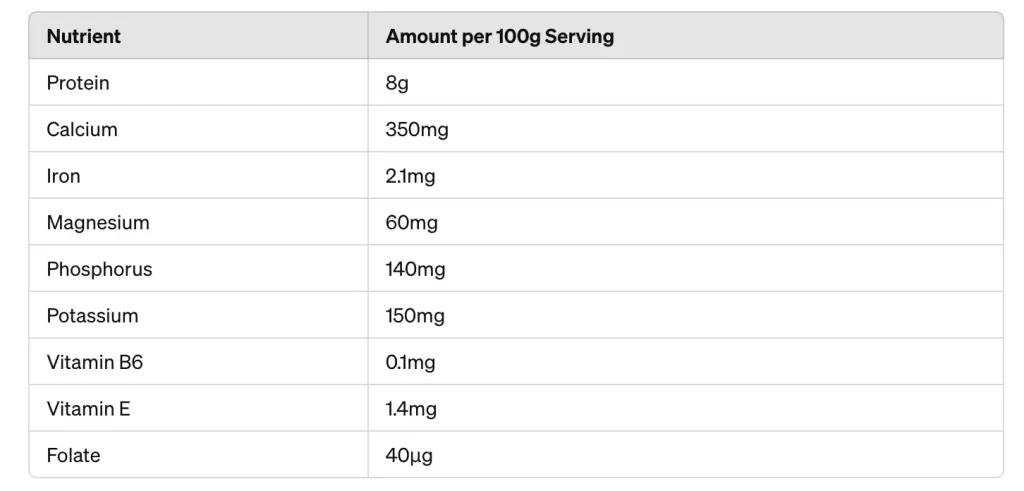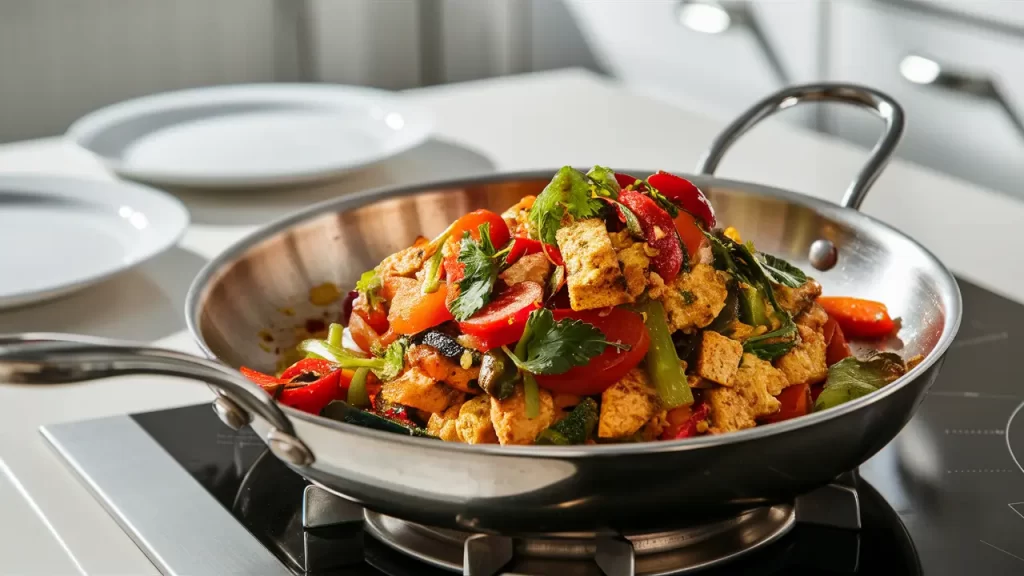
What is Tofu?
Tofu, also known as bean curd, is a versatile plant-based food that’s been a staple in Asian cuisines for centuries. Made from soybeans, tofu is popular for its high protein content, versatility, and mild flavor that readily absorbs flavors and seasonings. Tofu comes in various textures, each with its own unique culinary applications.
Over the last several thousand years, humans have constantly sought to create foods that were nutritious, versatile, and reliable. Tofu, the extraordinary soybean-based protein that’s now used in cuisines worldwide, is one such food.
In this comprehensive guide, we share the fascinating world of tofu – from its humble origins in ancient China to its modern-day status as a powerhouse ingredient in cuisines spanning the globe. Get ready to be inspired as we unravel the secrets behind this beloved culinary staple.
Whether you’re a tofu aficionado or a curious newcomer, there’s something here for you. Grab your fork and join us as we delve into the delightful world of tofu – where every bite tells a story.
Okay, So What is Tofu, Exactly?
Tofu, also known as bean curd, is a versatile vegan food that has been a staple in Asian cuisines for centuries. Made from soybeans, tofu is valued for its high protein content, versatility, and mild flavor that readily absorbs other flavors and seasonings.
Tofu comes in various forms, including silken, soft, firm, and extra-firm, each with its own unique texture and culinary applications.
A Brief History of Tofu: From Ancient China to Global Phenomenon

Tofu’s journey through history is as rich as its culinary uses. The story begins in ancient China, where (legend has it) its discovery was a happy accident.
As the story goes, a Chinese cook accidentally curdled soy milk with nigari, a natural coagulant derived from seawater, and that mistake resulted in the creation of tofu. While the exact origins of tofu remain a mystery, historical records note its first use in China during the Han dynasty (206 BCE – 220 CE).
Originally known as “doufu” in Chinese, tofu quickly gained popularity as a nutritious and affordable source of protein, particularly among Buddhist monks who followed vegetarian diets. From China, tofu spread to neighboring countries such as Japan, Korea, and Vietnam, where it became an integral part of their traditional cuisines.
How Tofu is Made
Tofu is made through the process of curdling. Fresh soy milk is combined with a coagulant, and the resulting curds are pressed into blocks.
The soy milk is made by soaking and grinding soybeans. The liquid extracted from the beans is then heated and combined with a chemical that binds the proteins together, such as calcium sulfate or magnesium chloride.
Finally, the curds are separated from the whey, pressed into molds, and left to set, resulting into blocks of tofu. The firmness of the tofu depends on how much water is pressed out of the curds.
Tofu: The Nutrient Profile
Tofu is a nutrient-dense food that provides a wealth of essential nutrients. It is low in calories and contains no cholesterol, making it a heart-healthy choice.
Tofu is an excellent source of protein, containing all nine essential amino acids, as well as minerals such as calcium, iron, and magnesium. Additionally, tofu is rich in vitamins like B vitamins (including B12 in fortified varieties) and vitamin E.

Health Benefits of Tofu
Tofu offers numerous health benefits, making it a valuable addition to any diet.
It is an excellent source of plant-based protein, making it an ideal choice for vegetarians and vegans. Since it is low in saturated fat and cholesterol, it may help reduce the risk of heart disease.
Additionally, tofu is rich in calcium, which is essential for bone health, as well as iron, which helps transport oxygen in the blood.
Types of Tofu

Part of what makes tofu so versatile is the variety of forms in which it is produced. It ranges in texture and firmness from silken tofu, the perfect smooth and creamy texture to blend into soups and sauces, to extra firm, which can easily replace meat in your favorite dishes. Each type is suited for a particular purpose.
- Silken tofu: The softest of all types. It’s perfect for making creamy soups or desserts.
- Soft tofu: Slightly firmer than silken, but still a delicate texture. Best for blending into smoothies or adding to stews like soondubu jjigae.
- Firm tofu: Noticeably firmer, holds its shape well. Ideal for stir-fries, grilling, or baking.
- Extra-firm tofu: Dense and sturdy, with a chewy mouthfeel. Can be used in most application as a meat substitute – suitable for slicing, cubing, and marinating.
- Yuba (tofu skin): Thin sheets formed on the surface of boiling soy milk. Most often used in wraps or stir-fries. Sometimes used as “skin” on eat substitutes because it crisps up well.
- Flavored and seasoned tofu: Pre-seasoned a cooked tofu is available in various flavors like teriyaki, barbecue, or curry. It can be a quick snack or the basis for a easy weeknight dinner.
| Type of Tofu | Texture/Firmness | Best Uses |
|---|---|---|
| Silken tofu | Smooth and creamy | Soups, sauces, desserts |
| Soft tofu | Tender and delicate | Smoothies, salads |
| Firm tofu | Holds shape well | Stir-fries, grilling, baking |
| Extra-firm tofu | Dense and sturdy | Slicing, cubing, marinating |
| Tofu skin (yuba) | Thin sheets | Wraps, stir-fries |
| Baked tofu (prepackaged) | Varies | Ready-to-eat, sandwiches, salads |
Culinary Uses of Tofu

Tofu is incredibly versatile and can be prepared using a variety of cooking methods. Softer forms are great for adding creaminess and body to soups, stews, smoothies and desserts. The firmer versions can be grilled, fried, baked, or steamed, and used in a wide range of dishes.
It is commonly used as a meat substitute in vegetarian and vegan cooking, replacing ingredients like chicken, pork, or beef in a host of dishes. In Asian cuisines, tofu is a key ingredient in dishes like mapo tofu, tofu soup, and tofu salad which may include both tofu and meat.
Tofu in Cuisine

Tofu has become increasingly popular in recent years, not only in traditional Asian cuisines but also in Western cooking.
Because it is so versatile and can take on so many different flavors and textures, it’s a favorite among home cooks and professional chefs alike.
From breakfast to dessert, tofu can easily become a staple in any kitchen, vegan or omni.
Common Myths About Tofu
Tofu is bland and flavorless.
While tofu has a mild taste on its own, it readily absorbs the flavors of other ingredients and seasonings.
You can transform tofu into just about anything you want – from a creamy chocolate mousse to crispy protein bites.
Tofu is only for vegans and vegetarians.
When tofu was created, it was not intended as just a food for vegetarians. Though it gained global popularity in plant-based diets, tofu is enjoyed by people of all dietary preferences and can be incorporated into a variety of dishes.
Tofu is genetically modified or unnatural.
Made from whole soybeans, water, and a coagulant, tofu is a natural, minimally processed food. There are few additives or chemicals in its original form.
Tofu is not a complete protein source.
Not true! Tofu contains all nine essential amino acids, making it a complete protein source.
Tips for Buying, Storing, and Using Tofu

- How to choose fresh tofu: Look for tofu packets that are intact. There should be no signs of bulging, discoloration or off odors.
- How to store tofu: Keep fresh tofu refrigerated in its original packaging. Once opened, keep it submerged in water in an airtight container. Change the water each day to ensure freshness.
Tofu in aseptic packaging (like silken tofu) is shelf stable until opened. Be sure to refrigerate immediately and use within 1-2 days. - How to prepare tofu for cooking: Drain the tofu and press out excess water. You can use a tofu press, or sandwich the block in cheesecloth between two weighted plates to extract as much water as possible. Freezing tofu will change its texture significantly, making it more dense and chewy.
- How to use tofu – recipe ideas: Experiment with tofu in dishes like tofu stir-fry, tofu scramble, tofu “egg” salad, and tofu desserts like chocolate mousse. It makes a wonderful egg substitute for baked goods as well.
The Wrap Up
Tofu is a versatile and nutritious ingredient that can be enjoyed in a variety of ways. Whether you’re a seasoned tofu foodie or new to the world of bean curd, there are countless ways to incorporate tofu into your diet and explore its culinary possibilities.
With its health benefits, versatility, and sustainability, tofu is truly a food for everyone to enjoy.






2 Comments